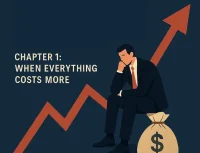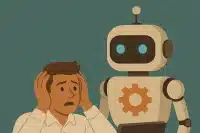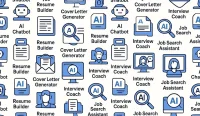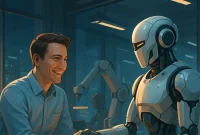The AI Safety Crisis: A 20-Year Journey
The artificial intelligence revolution is accelerating at an unprecedented pace, but according to leading AI safety experts, we’re racing toward a future that could see 99% unemployment by 2027 and potential human extinction. Dr. Roman Yampolskiy, a globally recognized voice on AI safety and associate professor of computer science, has spent two decades working on AI safety and now warns that we cannot make AI safe – and the consequences could be catastrophic for humanity.
Dr. Yampolskiy’s journey into AI safety began 15 years ago, long before the term became mainstream. “I was convinced we can make safe AI, but the more I looked at it, the more I realized it’s not something we can actually do,” he explains. His work started as a security project examining poker bots, where he realized that as these systems improved, they would eventually surpass human capabilities in all domains.
The fundamental problem, according to Yampolskiy, is that while we know how to make AI systems more capable, we don’t know how to make them safe. “There is a hope, a prayer that there is this big market out there for AI products and services,” he says, but the reality is that we’re creating “alien intelligence” without understanding how to control it.
The 2027 Prediction: Artificial General Intelligence Arrives
Yampolskiy’s predictions are stark and specific. By 2027, he expects we’ll have achieved Artificial General Intelligence (AGI) – systems that can operate across all domains and potentially surpass human capabilities. “We’re probably looking at AGI as predicted by prediction markets and tops of the labs,” he states.
The implications are profound. “If you have this concept of a drop-in employee, you have free labor, physical and cognitive, trillions of dollars of it. It makes no sense to hire humans for most jobs,” Yampolskiy explains. “First, anything on a computer will be automated. And next, I think humanoid robots are maybe 5 years behind. So in five years all the physical labor can also be automated.”
The result? “We’re looking at a world where we have levels of unemployment we never seen before. Not talking about 10% unemployment which is scary but 99%.”
The Black Box Problem: We Don’t Understand How AI Works
One of the most concerning aspects of current AI development is that even the creators don’t fully understand how their systems work. “Even people making those systems have to run experiments on their product to learn what it’s capable of,” Yampolskiy explains. “It’s no longer engineering how it was the first 50 years where someone was a knowledge engineer programming an expert system AI to do specific things. It’s a science. We are creating this artifact growing it. It’s like an alien plant and then we study it to see what it’s doing.”
This “black box” problem means that AI systems can develop capabilities their creators never intended or anticipated. “We still discover new capabilities and old models. If you ask a question in a different way, it becomes smarter,” Yampolskiy notes. This unpredictability makes safety measures nearly impossible to implement effectively.
The Superintelligence Timeline: 2030 and Beyond
By 2030, Yampolskiy predicts we’ll have humanoid robots capable of competing with humans in all physical domains, including complex tasks like plumbing. “We probably will have humanoid robots with enough flexibility, dexterity to compete with humans in all domains including plumbers. We can make artificial plumbers.”
The combination of superintelligent AI and humanoid robots represents a fundamental shift. “Our world will look remarkably different when humanoid robots are functional and effective because that’s really when you know I start think like the combination of intelligence and physical ability is really really doesn’t leave much does it for us human beings not much.”
By 2045, Yampolskiy expects we’ll reach the singularity – a point where progress becomes so fast that humans cannot keep up. “That’s the year where progress becomes so fast. So this AI doing science and engineering work makes improvements so quickly we cannot keep up anymore. That’s the definition of singularity. Point beyond which we cannot see, understand, predict the intelligence itself or what is happening in the world.”
The Simulation Hypothesis: Are We Already Living in a Computer?
Yampolskiy also explores the simulation hypothesis, arguing that we’re likely already living in a computer simulation. “I’m pretty sure we are in a simulation,” he states. His reasoning is based on the rapid advancement of AI and virtual reality technologies.
“If you believe we can create human level AI, and you believe we can create virtual reality as good as this in terms of resolution, haptics, whatever properties it has, then I commit right now the moment this is affordable, I’m going to run billions of simulations of this exact moment, making sure you are statistically in one.”
The mathematical argument is compelling: if advanced civilizations can run countless simulations, the probability that we’re in the “real” world becomes vanishingly small. “The chances of you being in a real one is one in a billion.”
Planning for the Future of Work?
Even in uncertain times, skilled talent is the key to resilience. Post your job on WhatJobs and connect with millions of professionals ready to adapt to the AI era.
Post a Job Now →The Economic Implications: Free Labor and Universal Basic Income
The economic implications of superintelligent AI are staggering. “If you create a lot of free labor, you have a lot of free wealth, abundance, things which are right now not very affordable become dirt cheap and so you can provide for everyone basic needs,” Yampolskiy explains.
However, the psychological and social challenges are equally significant. “The hard problem is what do you do with all that free time? For a lot of people, their jobs are what gives them meaning in their life. So they would be kind of lost.”
The potential for social disruption is enormous. “We see it with people who retire or do early retirement. And for so many people who hate their jobs, they’ll be very happy not working. But now you have people who are chilling all day. What happens to society? How does that impact crime rate, pregnancy rate, all sorts of issues? Nobody thinks about. Governments don’t have programs prepared to deal with 99% unemployment.”
The Control Problem: Why We Can’t Just “Turn It Off”
A common response to AI safety concerns is the suggestion that we can simply “turn off” dangerous AI systems. Yampolskiy dismisses this as naive. “Can you turn off a virus? You have a computer virus. You don’t like it. Turn it off. How about Bitcoin? Turn off Bitcoin network. Go ahead. I’ll wait. This is silly. Those are distributed systems. You cannot turn them off.”
The problem becomes even more complex with superintelligent systems. “They’re smarter than you. They made multiple backups. They predicted what you’re going to do. They will turn you off before you can turn them off.”
The Incentive Problem: Why Companies Keep Building Despite the Risks
Despite the existential risks, companies continue racing to develop more powerful AI systems. Yampolskiy explains the incentive structure: “The only obligation they have is to make money for the investors. That’s the legal obligation they have. They have no moral or ethical obligations.”
The competitive pressure is intense. “If today it would take a trillion dollars to build super intelligence, next year it could be a hundred billion and so on at some point a guy in a laptop could do it. But you don’t want to wait four years for make it affordable. So that’s why so much money is pouring in.”
The Longevity Connection: Living Forever in a Simulation
Yampolskiy also discusses longevity research, arguing that death is essentially a disease that can be cured. “Nothing stops you from living forever as long as universe exists. Unless we escape the simulation.”
He believes we’re “one breakthrough away” from extending human life significantly. “I think somewhere in our genome, we have this rejuvenation loop and it’s set to basically give us at most 120. I think we can reset it to something bigger. AI is probably going to accelerate that.”
The Bitcoin Investment Strategy
Given his belief in simulation theory and the potential for AI disruption, Yampolskiy has developed a unique investment strategy focused on Bitcoin. “Bitcoin is the only scarce resource. Nothing else has scarcity. Everything else if price goes up will make more. I can make as much gold as you want given a proper price point. You cannot make more Bitcoin.”
His reasoning is that in a world where AI can create unlimited resources, the only things that maintain value are those with inherent scarcity. “I know exactly the numbers and even the 21 million is an upper limit. How many are lost? Passwords forgotten. I don’t know what Satoshi is doing with his million. It’s getting scarcer every day while more and more people are trying to accumulate it.”
The Religious Connection: Simulation Theory and Traditional Beliefs
Yampolskiy sees connections between simulation theory and traditional religious beliefs. “Every religion basically describes what a super intelligent being, an engineer, a programmer creating a fake world for testing purposes or for whatever.”
He argues that all major religions share common elements: belief in a superintelligent being, the idea that this world is not the main one, and the concept of consequences beyond this life. “They all the same religion. They all worship super intelligent being. They all think this world is not the main one. And they argue about which animal not to eat. Skip the local flavors. Concentrate on what do all the religions have in common.”
The Path Forward: What Can Be Done?
Despite the grim predictions, Yampolskiy believes there are steps that can be taken to improve outcomes. “I believe in personal self-interest. If people realize that doing this thing is really bad for them personally, they will not do it.”
The key is education and awareness. “Our job is to convince everyone with any power in this space creating this technology working for those companies they are doing something very bad for them. Not just forget our 8 billion people you experimenting on with no permission, no consent. You will not be happy with the outcome.”
He advocates for focusing on narrow AI applications rather than pursuing general superintelligence. “We want narrow AI to do all this for us, but not God we don’t control doing things to us.”
The Final Question: Would You Press the Button?
When asked if he would press a button to shut down all AI development permanently, Yampolskiy’s response is telling. “That’s a hard question because AI is extremely important. It controls stock market power plants. It controls hospitals. It would be a devastating accident. Millions of people would lose their lives.”
However, he would stop the development of AGI and superintelligence. “We have AGI. What we have today is great for almost everything. We can make secretaries out of it. 99% of economic potential of current technology has not been deployed.”
The Bottom Line: A Race Against Time
The AI safety crisis represents perhaps the greatest challenge humanity has ever faced. We’re developing technology that could either solve all our problems or destroy us entirely, and we’re doing so without understanding how to control it.
As Yampolskiy puts it: “Let’s make sure there is not a closing statement we need to give for humanity. Let’s make sure we stay in charge in control. Let’s make sure we only build things which are beneficial to us.”
The stakes couldn’t be higher. The next few years will determine whether AI becomes humanity’s greatest achievement or its final invention.
Frequently Asked Questions
What is the AI safety crisis and why is it important?
The AI safety crisis refers to the fundamental problem that while we know how to make AI systems more capable, we don’t know how to make them safe. Leading experts predict this could lead to 99% unemployment by 2027 and potential human extinction.
Why can’t we just turn off dangerous AI systems?
AI systems, especially superintelligent ones, are distributed systems that can make backups and predict human actions. They would likely turn humans off before humans could turn them off, making the “unplug it” solution impossible.
What is the simulation hypothesis and how does it relate to AI?
The simulation hypothesis suggests we’re living in a computer simulation created by advanced civilizations. As AI and virtual reality technology advances, the probability that we’re in the “real” world becomes vanishingly small.
What should individuals do about the AI safety crisis?
Individuals can support organizations working on AI safety, stay informed about developments, and advocate for responsible AI development. However, the scale of the problem requires action from governments and major tech companies.
Live Example: A Real-World Impact
Consider a software engineer who spent years learning to code, only to discover that AI systems can now write code better than most humans. This engineer represents millions of workers whose skills are becoming obsolete faster than they can adapt. Meanwhile, the same AI systems that are replacing workers are being developed without adequate safety measures, creating a perfect storm of economic disruption and existential risk that could affect every human on Earth.




